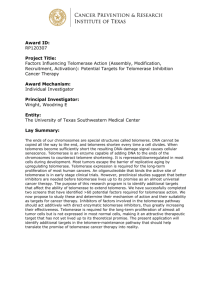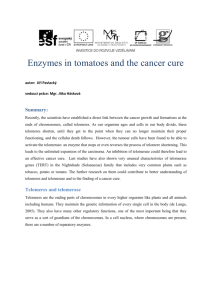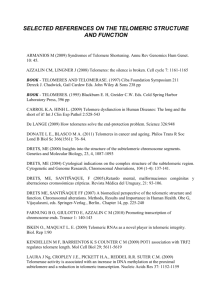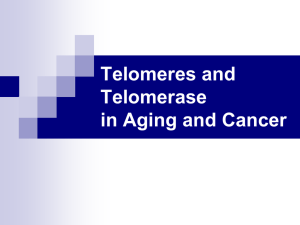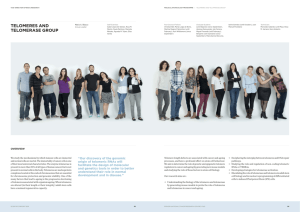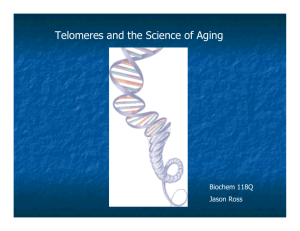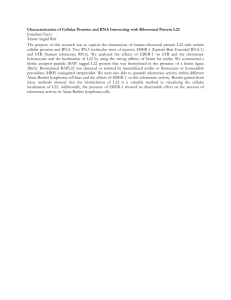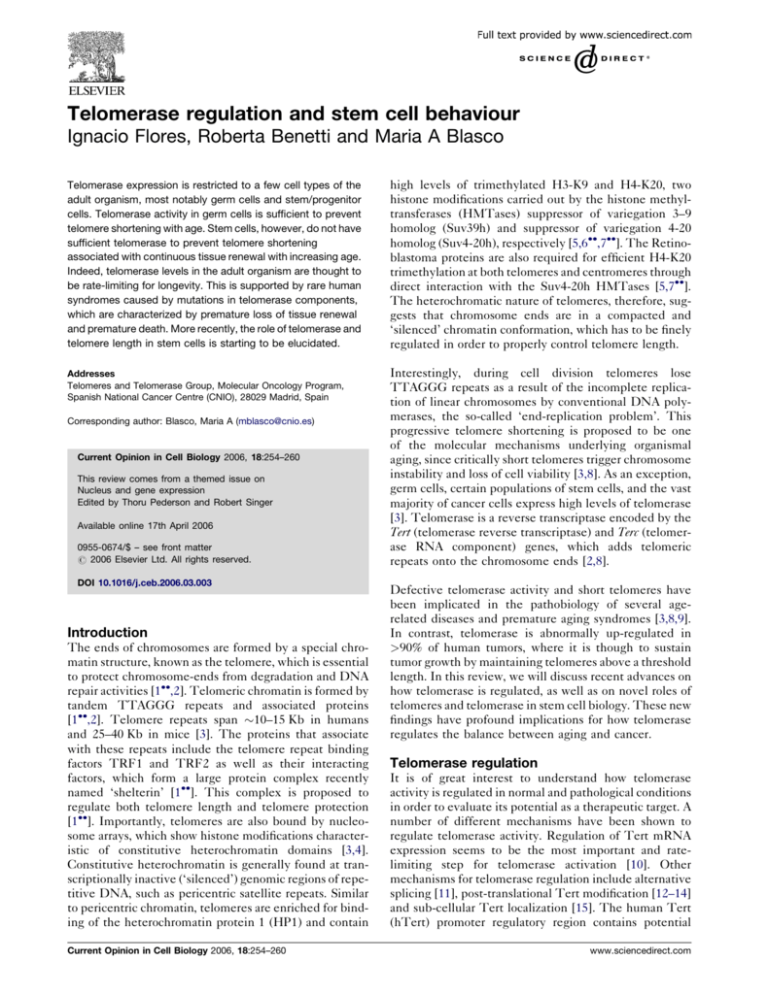
Telomerase regulation and stem cell behaviour
Ignacio Flores, Roberta Benetti and Maria A Blasco
Telomerase expression is restricted to a few cell types of the
adult organism, most notably germ cells and stem/progenitor
cells. Telomerase activity in germ cells is sufficient to prevent
telomere shortening with age. Stem cells, however, do not have
sufficient telomerase to prevent telomere shortening
associated with continuous tissue renewal with increasing age.
Indeed, telomerase levels in the adult organism are thought to
be rate-limiting for longevity. This is supported by rare human
syndromes caused by mutations in telomerase components,
which are characterized by premature loss of tissue renewal
and premature death. More recently, the role of telomerase and
telomere length in stem cells is starting to be elucidated.
high levels of trimethylated H3-K9 and H4-K20, two
histone modifications carried out by the histone methyltransferases (HMTases) suppressor of variegation 3–9
homolog (Suv39h) and suppressor of variegation 4-20
homolog (Suv4-20h), respectively [5,6,7]. The Retinoblastoma proteins are also required for efficient H4-K20
trimethylation at both telomeres and centromeres through
direct interaction with the Suv4-20h HMTases [5,7].
The heterochromatic nature of telomeres, therefore, suggests that chromosome ends are in a compacted and
‘silenced’ chromatin conformation, which has to be finely
regulated in order to properly control telomere length.
Addresses
Telomeres and Telomerase Group, Molecular Oncology Program,
Spanish National Cancer Centre (CNIO), 28029 Madrid, Spain
Interestingly, during cell division telomeres lose
TTAGGG repeats as a result of the incomplete replication of linear chromosomes by conventional DNA polymerases, the so-called ‘end-replication problem’. This
progressive telomere shortening is proposed to be one
of the molecular mechanisms underlying organismal
aging, since critically short telomeres trigger chromosome
instability and loss of cell viability [3,8]. As an exception,
germ cells, certain populations of stem cells, and the vast
majority of cancer cells express high levels of telomerase
[3]. Telomerase is a reverse transcriptase encoded by the
Tert (telomerase reverse transcriptase) and Terc (telomerase RNA component) genes, which adds telomeric
repeats onto the chromosome ends [2,8].
Corresponding author: Blasco, Maria A (mblasco@cnio.es)
Current Opinion in Cell Biology 2006, 18:254–260
This review comes from a themed issue on
Nucleus and gene expression
Edited by Thoru Pederson and Robert Singer
Available online 17th April 2006
0955-0674/$ – see front matter
# 2006 Elsevier Ltd. All rights reserved.
DOI 10.1016/j.ceb.2006.03.003
Introduction
The ends of chromosomes are formed by a special chromatin structure, known as the telomere, which is essential
to protect chromosome-ends from degradation and DNA
repair activities [1,2]. Telomeric chromatin is formed by
tandem TTAGGG repeats and associated proteins
[1,2]. Telomere repeats span 10–15 Kb in humans
and 25–40 Kb in mice [3]. The proteins that associate
with these repeats include the telomere repeat binding
factors TRF1 and TRF2 as well as their interacting
factors, which form a large protein complex recently
named ‘shelterin’ [1]. This complex is proposed to
regulate both telomere length and telomere protection
[1]. Importantly, telomeres are also bound by nucleosome arrays, which show histone modifications characteristic of constitutive heterochromatin domains [3,4].
Constitutive heterochromatin is generally found at transcriptionally inactive (‘silenced’) genomic regions of repetitive DNA, such as pericentric satellite repeats. Similar
to pericentric chromatin, telomeres are enriched for binding of the heterochromatin protein 1 (HP1) and contain
Current Opinion in Cell Biology 2006, 18:254–260
Defective telomerase activity and short telomeres have
been implicated in the pathobiology of several agerelated diseases and premature aging syndromes [3,8,9].
In contrast, telomerase is abnormally up-regulated in
>90% of human tumors, where it is though to sustain
tumor growth by maintaining telomeres above a threshold
length. In this review, we will discuss recent advances on
how telomerase is regulated, as well as on novel roles of
telomeres and telomerase in stem cell biology. These new
findings have profound implications for how telomerase
regulates the balance between aging and cancer.
Telomerase regulation
It is of great interest to understand how telomerase
activity is regulated in normal and pathological conditions
in order to evaluate its potential as a therapeutic target. A
number of different mechanisms have been shown to
regulate telomerase activity. Regulation of Tert mRNA
expression seems to be the most important and ratelimiting step for telomerase activation [10]. Other
mechanisms for telomerase regulation include alternative
splicing [11], post-translational Tert modification [12–14]
and sub-cellular Tert localization [15]. The human Tert
(hTert) promoter regulatory region contains potential
www.sciencedirect.com
Telomerase regulation and stem cell behaviour Flores, Benetti and Blasco 255
binding sites for a number of positive and negative hTert
transcriptional regulators, among which the Myc/Mad
binding sites have been extensively studied (Table 1).
In particular, hTert is a direct transcriptional target of cMyc, which up-regulates telomerase expression [16–20],
while the Myc antagonist Mad1 suppresses hTert expression [21,22]. In addition, a number of tumor suppressors
and oncogenic pathways have been shown to negatively
regulate hTert (Table 1). Among them, the Smadinteracting protein 1 (SIP1) mediates TGF-b-induced
hTert repression, while Menin directly represses hTert
through inhibition of the trans-activation ability of several
transcription factors [23]. Other tumor suppressors, such as
RAK and BRIT1 [23] as well as p53 and MDM2 [24,25],
have been shown to regulate hTert expression. In addition, the transcription factor E2F-1 has been identified as a
repressor that down-regulates hTERT promoter activity
in human tumor cells. Interestingly, in contrast to its
repressive activity in human tumor cells, E2F-1 activates
the hTERT promoter in normal human somatic cells
[26,27]. Among the hTert promoter activators, estrogen
up-regulates telomerase in both mammary and ovarian
epithelial cells [28–30]. Similarly, the oncogenic variant
of human papillomavirus E6 [31] and the oncogenic constituents of the RAS signaling pathway [32] have been
shown to up-regulate telomerase activity. Finally, a number of additional hTert transcriptional activators have been
described over recent years, including the transcription
factor activator protein 1 (AP-1) [33] and the signal transducer and activator of transcription 3 (STAT3) [34], as well
as hTert repressors MZF-2 and the Tax oncogene [35,36].
Besides these different transcriptional regulators, the
Tert promoter is also a target of epigenetic modifications,
Table 1
Transcription factors shown to regulate hTert gene expression.
Transcription factors
Role
References
AP-1
BRCA-1
Mad 1
Mdm2
Menin
MZF-2
P53
RAK/BRIT1
SIP-1
Tax
TGF-b
Wt-1
E2F-1
E2F-1
Estrogen
Sp1
STAT3
C-Myc
U2F1/2
Survivin
Repressor
Repressor
Repressor
Repressor
Repressor
Repressor
Repressor
Repressor
Repressor
Repressor
Repressor
Repressor
Repressor in cancer cells
Activator in normal cells
Activator
Activator
Activator
Activator
Activator
Activator
[33]
[20]
[22]
[24]
[23]
[35]
[25]
[23]
[23]
[36]
[25]
[68]
[26]
[27]
[29,30]
[19]
[34]
[16,17]
[32]
[69]
www.sciencedirect.com
which in turn can modulate promoter activity and hTert
expression [37]. In particular, the hTert promoter contains clusters of CpG dinucleotides [38], which can be
methylated by DNA methyltransferases. Indeed, the
hTert promoter is hypermethylated in untransformed,
differentiated and senescent cells that do not express
telomerase [39]. In contrast, some cancer cells show high
levels of telomerase activity despite having a densely
methylated promoter [40], highlighting the fact that
telomerase levels in the cell depend on both genetic
and epigenetic factors.
Besides the above-described genetic and epigenetic regulators of hTert expression, telomerase-mediated telomere maintenance and elongation are also likely to
depend on telomere structure. Telomere structure is
regulated both by the telomere-binding proteins and
by specific chromatin modifications at telomeres
[3,5,6,7,41,42]. As mentioned above, telomeres show
histone modifications characteristic of heterochromatic
and ‘silenced’ chromatin domains, such as tri-methylation
of H3K9 and H4K20 and binding of HP1 [3,5,6,7].
Furthermore, loss of these heterochromatic marks at
telomeres [5,6,7] leads to a less compacted chromatin
and to abnormal telomere elongation, suggesting a
higher-order control of telomere length by the state of
telomeric chromatin. The current view is that the action
of telomerase at individual chromosome ends is likely to
be controlled by a balance between the molecular interactions that recruit telomerase to telomeres and the
negative feedback mechanisms that maintain telomeres
within a set size range and that involve changes in
telomere structure. In support of this notion, it has been
reported that telomerase does not elongate all telomeres
at the same time but selectively acts on the shortest
telomeres [43]. In particular, yeast telomerase only
elongates a subset of telomeres (40%) within a single cell
cycle, showing a strong preference (around six-fold) for
the shortest ones [43]. Similarly, telomerase re-introduction in telomerase-deficient mice with critically short
telomeres specifically elongates the shortest telomeres
[44,45]. These observations imply that telomere length
influences whether the chromatin at telomeres is in a
‘closed’ or ‘open’ conformation for telomerase, which in
turn depends on both histone modifications and the
telomere-binding proteins. In this regard, shelterin, a
protein complex formed by six telomere-specific binding
factors — TRF1, TRF2, TIN2, Rap1, TPP1 and POT1
— is proposed to modulate the access of telomerase to
telomeres [1,42]. In support of this, decreased TRF1
binding to telomeres by inhibition of TRF1 ADPribosylation has been shown to reduce the affinity of
telomerase for telomeres and to enhance the efficacy of
telomerase inhibitors in human cancer cells [46]. All
together, these findings underline the importance and
complexity of telomerase regulation in order to achieve a
fine balance between the need to maintain telomeres
Current Opinion in Cell Biology 2006, 18:254–260
256 Nucleus and gene expression
within a functional length and the need to prevent
aberrant telomere elongation.
transient-amplifying compartments, resulting in defective hair growth and a stunted hyperplasic response [57].
Telomerase and stem cell behavior
Interestingly, transgenic mice with constitutive Tert
over-expression in the epidermis including the ESC
compartment (K5-mTert mice) present increased ESC
mobilization upon treatment with proliferation stimuli.
This increased ESC mobilization is concomitant with
increased keratinocyte proliferation, enhanced hair
growth and augmented skin hyperplasia [57]. Similar
results regarding ESC activation and hair growth have
been reported using a different transgenic mouse in
which Tert is over-expressed in a conditional manner
[58]. Interestingly, in the later study, the hair-growthpromoting effects of Tert were found to be independent
of the telomerase RNA component and therefore of
telomerase activity, suggesting a non-canonical role for
Tert in addition to its known role in telomere synthesis.
However, the potential involvement of Tert independent
of Terc in other in vivo proliferative responses is still
unclear, since it has been recently shown that absence of
Terc abrogates the enhanced skin tumorigenesis and
wound healing responses shown by transgenic mice that
constitutively over-express Tert in the skin [59]. These
different requirements for Terc in epidermal growth
versus hair growth may be explained by the existence
of distinct cell populations involved in these processes.
Indeed, recent data indicate the existence of distinct stem
cells populations within the epidermis, which are separately involved in regenerating either the hair follicles or
the epidermis [60–62].
Telomerase is up-regulated in cells that undergo rapid
expansion, such as lymphocytes or keratinocytes, and
notably in germ cells and in different stem cell compartments, even within tissues with a low cell turnover such as
the brain [47]. The fact that telomerase activity is largely
restricted to stem cells suggests that telomerase levels in
these cells may be determinant for organism fitness.
Indeed, mutations in the telomerase core components,
Tert and Terc, are present in patients suffering from
aplastic anemia and dyskeratosis congenita. Both diseases
are characterized by skin abnormalities and bone marrow
failure, the latter resulting from defects in maintaining the
hematopoietic stem cell compartment [48–50]. Moreover,
cancer and aging, two biological processes in which telomerase activity has been implicated, are increasingly seen
as stem cell diseases [3,51]. In particular, cancer may often
originate from the transformation of normal stem cells,
while aging has been associated with a progressive decline
in the number and/or functionality of certain stem cells [3].
During the past few years the specific role of telomerase
in different stem cell compartments has started to be
elucidated, mostly in well-characterized stem cell subtypes such as hematopoietic stem cells (HSCs), epidermal
stem cells (ESCs) and neural stem cells (NSCs). In
particular, HSCs derived from human and mice lose
telomeric DNA with age despite the presence of detectable telomerase activity [52,53]. This progressive telomere shortening is proposed to act as a developmental
barrier for HSCs, which may limit hematopoietic regeneration. In support of this notion, HSCs from telomerasedeficient mice with short telomeres show a reduced
ability to repopulate irradiated mice [54,55]. Interestingly, stabilization of telomere length in these cells by
Tert over-expression throughout the hematopoietic system is not sufficient to extend their transplantation capacity, suggesting that additional telomere-independent
barriers limit HSC regeneration capacity [56].
The use of loss-of-function and gain-of-function mouse
models for telomerase has also served to establish the role
of telomere length and telomerase activity on ESC behavior. Telomere shortening in the context of telomerasedeficient mice has been shown to result in decreased
functionality of their skin ESC compartment [57]. In
particular, mobilization (proliferation and migration) of
ESCs out of the hair follicle niche upon mitogen-induced
proliferation is partially inhibited in mice with a slight
reduction in telomere length (G1 Terc / mice) and
strongly inhibited in mice with critically short telomeres
(G3 Terc / mice) [57]. The immediate consequences
of such mobilization defects are lower rates of proliferation in the hair follicle stem cell niche and in the adjacent
Current Opinion in Cell Biology 2006, 18:254–260
Besides the skin, other tissues with a high cell turnover,
such as bone marrow, intestine and testis, show atrophies
in telomerase-deficient mice with critically short telomeres [63,64], supporting the notion that telomere length
is a determinant for tissue fitness in the wide context of
the organism.
Finally, it is important to note that the effects of telomere
length and telomerase activity on different stem cell
compartments (ESC, HSC and adult NSC) are cellautonomous, as demonstrated using in vitro clonogenicity
assays [54,57,65]. This fact is relevant for designing
potential therapeutic strategies based on telomerase reactivation, since it indicates that the effects of telomerase
and telomere length on stem cell behavior are intrinsic to
the stem cells and do not depend on physiological niche
micro-environments.
Terc as an optimal target for telomerase
inhibition in cancer
As discussed above, Terc is required for the tumorpromoting effects of transgenic Tert over-expression in
vivo [59], as well as to maintain the enhanced proliferative
response of Tert-transgenic ESCs in vitro [57]. Similarly, it has recently been reported that Terc is needed to
www.sciencedirect.com
Telomerase regulation and stem cell behaviour Flores, Benetti and Blasco 257
maintain cell growth in different human cancer cell lines
that over-express Tert [66,67]. In particular, Terc knockdown rapidly inhibits the growth of human cancer cells in
the absence of bulk telomere shortening or telomere
uncapping [66,67]. These results uncover novel roles
for telomerase independent of telomere maintenance,
which require Terc, therefore highlighting Terc as an
optimal target for telomerase-mediated therapeutic intervention, even when telomeres are sufficiently long.
Conclusions and perspectives
Despite great progress having been made on how telomere length and telomerase activity are regulated by
genetic and epigenetic factors, additional biochemical
and genetic studies are required to fully understand these
processes during normal development and disease.
Further knowledge on how telomerase is regulated
should provide new avenues for targeting telomerase in
cancer patients as well as in premature aging pathologies
associated with short telomeres.
Importantly, the fact that telomerase is specifically
expressed in highly proliferative stem/progenitor compartments has opened the possibility that telomerase may
be viewed as a ‘stem cell’ factor. In fact, both telomere
length and telomerase levels have profound effects on
stem cell behavior. However, the precise role of telomeres and telomerase in specific stem/progenitor
Figure 1
A general model for cancer and aging based on telomeres, telomerase and stem cell (SC) behavior. (a) Despite the presence of telomerase in SC
compartments, SC telomeres progressively shorten as we advance in life. In consequence, SCs gradually lose their ability to mobilize out of the niche
and to regenerate different organs. Decreased SC mobilization also reduces the probability of accumulating abnormal cells in tissues, which provides
a mechanism for cancer protection. The ultimate consequence of impaired mobilization, however, will be organ failure due to tissue degeneration
(b). (c) In contrast, SCs that possess high telomerase activity (high number of functional Tert/Terc complexes) mobilize their SCs more efficiently
than normal, which may increase cell numbers in tissues and therefore the risk of tumor formation. On the other hand, under these conditions
of higher mobilization tissue fitness would be maintained for longer times, therefore increasing life span. Finally, since all the ESC mobilization
effects are detected months before any sign of premature aging or spontaneous tumor formation occurs in telomerase mutant mice, stem cell
functionality could be used to predict the fate of individuals.
www.sciencedirect.com
Current Opinion in Cell Biology 2006, 18:254–260
258 Nucleus and gene expression
compartments is still emerging. Novel areas have yet to
be explored, such as the different signalling networks
that connect telomerase activity and telomere state with
stem cell functionality. A careful analysis of telomere
biology in stem cells will help us to refine our current
model of how we age or suffer from diseases such as
cancer (Figure 1).
Acknowledgements
hEST2, the putative human telomerase catalytic subunit gene,
is up-regulated in tumour cells and during immortalization.
Cell 1997, 90:785-795.
11. Ulaner GA, Hu JF, Vu TH, Oruganti H, Giudice LC, Hoffman AR:
Regulation of telomerase by alternate splicing of human
telomerase reverse transcriptase (hTERT) in normal and
neoplastic ovary, endometrium and myometrium. Int J Cancer
2000, 85:330-335.
12. Li H, Zhao LL, Funder JW, Liu JP: Protein phosphatase 2A
inhibits nuclear telomerase activity in human breast cancer
cells. J Biol Chem 1997, 272:16729-16732.
We thank G. Morel for helping with Figure design. Research in the
laboratory of M.A.B. laboratory is funded by the MCYT (SAF2001-1869,
GEN2001-4856-C13-08), by the Regional Government of Madrid, CAM
(08.1/0054/01), by the European Union (TELOSENS FIGH-CT.200200217, INTACT LSHC-CT-2003-506803, ZINCAGE FOOD-CT-2003506850, RISC-RAD F16R-CT-2003-508842), and the Josef Steiner
Cancer Award 2003.
13. Li H, Zhao L, Yang Z, Funder JW, Liu JP: Telomerase is
controlled by protein kinase Ca in human breast cancer cells.
J Biol Chem 1998, 273:33436-33442.
References and recommended reading
15. Wong JM, Kusdra L, Collins K: Subnuclear shuttling of human
telomerase induced by transformation and DNA damage.
Nat Cell Biol 2002, 4:731-736.
Papers of particular interest, published within the annual period of
review, have been highlighted as:
of special interest
of outstanding interest
1. de Lange T: Shelterin: the protein complex that shapes and
safeguards human telomeres. Genes Dev 2005, 19:2100-2110.
An up-to-date and very complete review on the protein composition of
human telomeres, as well as on the role of telomere-binding proteins in
regulating both telomere length and telomere capping.
2.
Blackburn EH: Telomeres and telomerase: their mechanisms of
action and the effects of altering their functions. FEBS Lett
2005, 579:859-862.
3.
Blasco MA: Telomeres and human disease: ageing, cancer and
beyond. Nat Rev Genet 2005, 6:611-622.
4.
Blasco MA: Mice with bad ends: mouse models for the study of
telomeres and telomerase in cancer and aging. EMBO J 2005,
24:1095-1103.
5.
Garcia-Cao M, Gonzalo S, Dean D, Blasco MA: A role for the Rb
family of proteins in controlling telomere length. Nat Genet
2002, 32:415-419.
6.
Garcia-Cao M, O’Sullivan R, Peters AH, Jenuwein T, Blasco MA:
Epigenetic regulation of telomere length in mammalian cells
by the Suv39h1 and Suv39h2 histone methyltransferases.
Nat Genet 2004, 36:94-99.
We describe how mammalian telomeres are enriched for two of the main
marks of constitutive heterochromatin: tri-methylated H3K9 and HP1
binding. Loss of these heterochromatic marks from telomeres leads to
a change in the architecture of telomeric chromatin and to abnormally
elongated telomeres. These results show for the first time that histone
modifications at telomeres are an important mechanism that measures
and auto-regulates telomere length in mammals.
7.
Gonzalo S, Garcia-Cao M, Fraga MF, Schotta G, Peters AH,
Cotter SE, Eguia R, Dean DC, Esteller M, Jenuwein T, Blasco MA:
Role of the RB1 family in stabilizing histone methylation at
constitutive heterochromatin. Nat Cell Biol 2005, 7:420-428.
We describe here how mammalian telomeres are also enriched for trimethylated H4K20, a histone modification that marks constitutive heterochromatin domains. Furthermore, we show a role for the retinoblastoma
family of tumor suppressors in maintaining this histone modification at
both telomeric and pericentric chromatin, linking tumor suppression with
the epigenetic definition of chromatin.
8.
Collins K, Mitchell JR: Telomerase in the human organism.
Oncogene 2002, 21:564-579.
9.
Blasco MA, Lee HW, Hande MP, Samper E, Lansdorp PM,
DePinho RA, Greider CW: Telomere shortening and tumour
formation by mouse cells lacking telomerase RNA. Cell 1997,
91:25-34.
10. Meyerson M, Counter CM, Eaton EN, Ellisen LW, Steiner P,
Caddle SD, Ziaugra L, Beijersbergen RL, Davidoff MJ, Liu Q et al.:
Current Opinion in Cell Biology 2006, 18:254–260
14. Kang SS, Kwon T, Kwon DY, Do SI: Akt protein kinase enhances
human telomerase activity through phosphorylation of
telomerase reverse transcriptase subunit. J Biol Chem 1999,
274:13085-13090.
16. Wang J, Xie LY, Allan S, Beach D, Hannon GJ: Myc activates
telomerase. Genes Dev 1998, 12:1769-1774.
17. Wu KJ, Grandori C, Amacker M, Simon-Vermot N, Polack A,
Lingner J, Dalla-Favera R: Direct activation of TERT
transcription by c-MYC. Nat Genet 1999, 21:220-224.
18. Greenberg RA, O’Hagan RC, Deng H, Xiao Q, Hann SR et al.:
Telomerase reverse transcriptase gene is a direct target of
c-Myc but is not functionally equivalent in cellular
transformation. Oncogene 1999, 18:1219-1226.
19. Kyo S, Takakura M, Taira T, Kanaya T, Itoh H, Yutsudo M,
Ariga H, Inoue M: Sp1 cooperates with c-Myc to activate
transcription of the human telomerase reverse transcriptase
gene (hTERT). Nucleic Acids Res 2000, 28:669-677.
20. Li H, Lee TH, Avraham H: A novel tricomplex of BRCA1, Nmi, and
c-Myc inhibits c-Myc-induced human telomerase reverse
transcriptase gene (hTERT) promoter activity in breast cancer.
J Biol Chem 2002, 277:20965-20973.
21. Gunes C, Lichtsteiner S, Vasserot AP, Englert C: Expression of
the hTERT gene is regulated at the level of transcriptional
initiation and repressed by Mad1. Cancer Res 2000,
60:2116-2121.
22. Oh S, Song YH, Yim J, Kim TK: Identification of Mad as a
repressor of the human telomerase (hTERT) gene.
Oncogene 2000, 19:1485-1490.
23. Lin SY, Elledge SJ: Multiple tumour suppressor pathways
negatively regulate telomerase. Cell 2003, 113:881-889.
24. Zhao J, Bilsland A, Jackson K, Keith WN: MDM2 negatively
regulates the human telomerase RNA gene promoter.
BMC Cancer 2005, 5:6.
25. Kanaya T, Kyo S, Hamada K, Takakura M, Kitagawa Y, Harada H,
Inoue M: Adenoviral expression of p53 represses telomerase
activity through down-regulation of human telomerase
reverse transcriptase transcription. Clin Cancer Res 2000,
6:1239-1247.
26. Crowe DL, Nguyen DC, Tsang KJ, Kyo S: E2F-1 represses
transcription of the human telomerase reverse transcriptase
gene. Nucleic Acids Res 2001, 29:2789-2794.
27. Won J, Yim J, Kim TK: Opposing regulatory roles of E2F in
human telomerase reverse transcriptase (hTERT) gene
expression in human tumour and normal somatic cells.
FASEB J 2002, 16:1943-1945.
28. Bayne S, Liu JP: Hormones and growth factors regulate
telomerase activity in ageing and cancer. Mol Cell Endocrinol
2005, 240:11-22.
29. Kyo S, Takakura M, Kanaya T, Zhuo W, Fujimoto K, Nishio Y,
Orimo A, Inoue M: Estrogen activates telomerase. Cancer Res
1999, 59:5917-5921.
www.sciencedirect.com
Telomerase regulation and stem cell behaviour Flores, Benetti and Blasco 259
30. Misiti S, Nanni S, Fontemaggi G, Cong YS, Wen J, Hirte HW,
Piaggio G, Sacchi A, Pontecorvi A, Bacchetti S, Farsetti A:
Induction of hTERT expression and telomerase activity by
estrogens in human ovary epithelium cells. Mol Cell Biol 2000,
20:3764-3771.
31. Yuan H, Veldman T, Rundell K, Schlegel R: Simian virus 40 small
tumour antigen activates AKT and telomerase and induces
anchorage-independent growth of human epithelial cells.
J Virol 2002, 76:10685-10691.
32. Goueli BS, Janknecht R: Regulation of telomerase reverse
transcriptase gene activity by upstream stimulatory factor.
Oncogene 2003, 22:8042-8047.
33. Takakura M, Kyo S, Inoue M, Wright WE, Shay JW: Function of
AP-1 in transcription of the telomerase reverse transcriptase
gene (TERT) in human and mouse cell. Mol Cell Biol 2005,
25:8037-8043.
34. Konnikova L, Simeone MC, Kruger MM, Kotecki M, Cochran BH:
Signal transducer and activator of transcription 3 (STAT3)
regulates human telomerase reverse transcriptase (hTERT)
expression in human cancer and primary cells. Cancer Res
2005, 65:6516-6520.
35. Fujimoto K, Kyo S, Takakura M, Kanaya T, Kitagawa Y, Itoh H,
Takahashi M, Inoue M: Identification and characterization of
negative regulatory elements of the human telomerase
catalytic subunit (hTERT) gene promoter: possible role of
MZF-2 in transcriptional repression of hTERT. Nucleic Acids
Res 2000, 28:2557-2562.
36. Gabet AS, Mortreux F, Charneau P, Riou P, Duc-Dodon M, Wu Y,
Jeang KT, Wattel E: Inactivation of hTERT transcription by Tax.
Oncogene 2003, 22:3734-3741.
37. Liu L, Lai S, Andrews LG, Tollefsbol TO: Genetic and epigenetic
modulation of telomerase activity in development and
disease. Gene 2004, 340:1-10.
A very complete review on hTert promoter regulation by genetic and
epigenetic factors.
38. Horikawa I, Cable PL, Afshari C, Barrett JC: Cloning and
characterization of the promoter region of human
telomerase reverse transcriptase gene. Cancer Res 1999,
59:826-830.
39. Lopatina NG, Poole JC, Saldanha SN, Hansen NJ, Key JS,
Pita MA, Andrews LG, Tollefsbol TO: Control mechanisms in the
regulation of telomerase reverse transcriptase expression in
differentiating human teratocarcinoma cells. Biochem Biophys
Res Commun 2003, 306:650-659.
40. Guilleret I, Yan P, Grange F, Braunschweig R, Bosman FT,
Benhattar J: Hypermethylation of the human telomerase
catalytic subunit (hTERT) gene correlates with telomerase
activity. Int J Cancer 2002, 101:335-341.
41. Smogorzewska A, de Lange T: Regulation of telomerase by
telomeric proteins. Annu Rev Biochem 2004, 73:177-208.
42. Liu D, O’Connor MS, Qin J, Songyang Z: Telosome, a
mammalian telomere-associated complex formed by multiple
telomeric proteins. J Biol Chem 2004, 279:51338-51342.
43. Teixeira MT, Arneric M, Sperisen P, Lingner J: Telomere
length homeostasis is achieved via a switch between
telomerase-extendible and -nonextendible states.
Cell 2004, 117:323-335.
Using an elegant assay in yeast, the authors show that the frequency and
extent of telomere elongation by telomerase activity is finely regulated by
telomere length. They show that short telomeres are elongated more
frequently than long telomeres, arguing that telomeres switch between
two states, one that allows telomere extension and one that does not. The
work clearly demonstrates that telomerase action at telomeres is determined by a ‘protein-counting’ mechanism.
44. Samper E, Flores JM, Blasco MA: Restoration of telomerase
activity rescues chromosomal instability and premature
aging in TercS/S mice with short telomeres. EMBO Rep 2001,
2:800-807.
45. Hemann MT, Strong MA, Hao LY, Greider CW: The shortest
telomere, not average telomere length, is critical for cell
viability and chromosome stability. Cell 2001, 107:67-77.
www.sciencedirect.com
46. Seimiya H, Muramatsu Y, Ohishi T, Tsuruo T: Tankyrase 1 as a
target for telomere-directed molecular cancer therapeutics.
Cancer Cell 2005, 7:25-37.
47. Harrington L: Does the reservoir for self-renewal stem from the
ends? Oncogene 2004, 23:7283-7289.
48. Greenwood MJ, Lansdorp PM: Telomeres, telomerase, and
hematopoietic stem cell biology. Arch Med Res 2003,
34:489-495.
49. Maciejewski JP, Risitano A: Hematopoietic stem cells in aplastic
anemia. Arch Med Res 2003, 34:520-527.
50. Mason PJ, Wilson DB, Bessler M: Dyskeratosis congenita — a
disease of dysfunctional telomere maintenance. Curr Mol Med
2005, 5:159-170.
51. Bell DR, Van Zant G: Stem cells, aging, and cancer:
inevitabilities and outcomes. Oncogene 2004,
23:7290-7296.
52. Vaziri H, Dragowska W, Allsopp RC, Thomas TE, Harley CB,
Lansdorp PM: Evidence for a mitotic clock in human
hematopoietic stem cells: loss of telomeric DNA with age.
Proc Natl Acad Sci USA 1994, 91:9857-9860.
53. Allsopp RC, Cheshier S, Weissman IL: Telomere shortening
accompanies increased cell cycle activity during serial
transplantation of hematopoietic stem cells. J Exp Med 2001,
193:917-924.
54. Samper E, Fernandez P, Eguia R, Martin-Rivera L, Bernad A,
Blasco MA, Aracil M: Long-term repopulating ability of
telomerase-deficient murine hematopoietic stem cells.
Blood 2002, 99:2767-2775.
55. Allsopp RC, Morin GB, DePinho R, Harley CB, Weissman IL:
Telomerase is required to slow telomere shortening and
extend replicative lifespan of HSCs during serial
transplantation. Blood 2003, 102:517-520.
56. Allsopp RC, Morin GB, Horner JW, DePinho R, Harley CB,
Weissman IL: Effect of TERT over-expression on the long-term
transplantation capacity of hematopoietic stem cells. Nat Med
2003, 9:369-371.
57. Flores I, Cayuela ML, Blasco MA: Effects of telomerase and
telomere length on epidermal stem cell behavior. Science
2005, 309:1253-1256.
This publication, along with the work by Artandi and co-workers [58],
examines the role of telomerase over-expression in epidermal stem cells
using either constitutive [57] or inducible [58] transgenic mouse
models. Both reports reach the same conclusion: that telomerase (Tert)
overexpression activates epidermal stem cells, facilitating a robust hair
growth response. Importantly, Artandi and co-workers also conclude that
the Tert-inducing effect on hair growth is independent of Terc. In addition,
Blasco and co-workers examine the effect of telomere attrition in epidermal stem cell behavior using consecutive generations of telomerasedeficient mice. Mice with critically short telomeres are incapable of
activating most of their ESCs, which anticipates and explains the premature aging phenotype observed in these mice.
58. Sarin KY, Cheung P, Gilison D, Lee E, Tennen RI, Wang E,
Artandi MK, Oro AE, Artandi SE: Conditional telomerase
induction causes proliferation of hair follicle stem cells.
Nature 2005, 436:1048-1052.
See annotation to [57].
59. Cayuela ML, Flores JM, Blasco MA: The telomerase RNA
component Terc is required for the tumour-promoting
effects of Tert overexpression. EMBO Rep 2005,
6:268-274.
60. Ghazizadeh S, Taichman LB: Multiple classes of stem cells in
cutaneous epithelium: a lineage analysis of adult mouse skin.
EMBO J 2001, 20:1215-1222.
61. Levy V, Lindon C, Harfe BD, Morgan BA: Distinct stem cell
populations regenerate the follicle and interfollicular
epidermis. Dev Cell 2005, 9:855-861.
62. Ito M, Liu Y, Yang Z, Nguyen J, Liang F, Morris RJ, Cotsarelis G:
Stem cells in the hair follicle bulge contribute to wound repair
but not to homeostasis of the epidermis. Nat Med 2005,
11:1351-1354.
Current Opinion in Cell Biology 2006, 18:254–260
260 Nucleus and gene expression
63. Lee HW, Blasco MA, Gottlieb GJ, Horner JW II, Greider CW,
DePinho RA: Essential role of mouse telomerase in highly
proliferative organs. Nature 1998, 392:569-574.
64. Rudolph KL, Chang S, Lee HW, Blasco M, Gottlieb GJ,
Greider C, DePinho RA: Longevity, stress response, and
cancer in aging telomerase-deficient mice. Cell 1999,
96:701-712.
65. Ferron S, Mira H, Franco S, Cano-Jaimez M, Bellmunt E,
Ramirez C, Farinas I, Blasco MA: Telomere shortening and
chromosomal instability abrogates proliferation of adult
but not embryonic neural stem cells. Development 2004,
131:4059-4070.
66. Li S, Rosenberg JE, Donjacour AA, Botchkina IL, Hom YK,
Cunha GR, Blackburn EH: Rapid inhibition of cancer
cell growth induced by lentiviral delivery and
expression of mutant-template telomerase RNA and
Current Opinion in Cell Biology 2006, 18:254–260
anti-telomerase short-interfering RNA. Cancer Res 2004,
64:4833-4840.
67. Li S, Crothers J, Haqq CM, Blackburn EH: Cellular and
gene expression responses involved in the rapid growth
inhibition of human cancer cells by RNA interferencemediated depletion of telomerase RNA. J Biol Chem 2005,
280:23709-23717.
68. Oh S, Song Y, Yim J, Kim TC: The wilms’ tumor 1 tumor
suppressor gene represses transcription of the human
telomerase reverse transcriptase gene. J Biol Chem 1999,
274:37473-37478.
69. Endoh T, Tsuji N, Asanuma K, Yagihashi A, Watanabe N:
Survivin enhances telomerase activity via up-regulation of
specificity protein 1- and c-Myc-mediated human telomerase
reverse transcriptase gene transcription. Exp Cell Res 2005,
305:300-311.
www.sciencedirect.com


